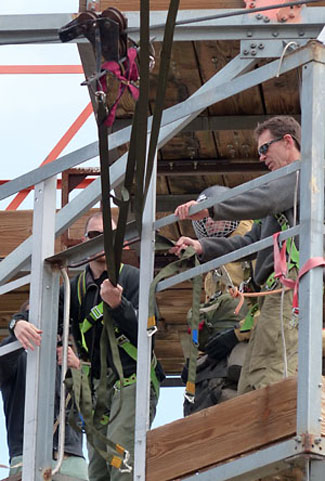home | internet service | web design | business directory | bulletin board | advertise | events calendar | contact | weather | cams

|
 A tap on the shoulder signals each smokejumper to exit the aircraft, in this case exit the practice tower. A tap on the shoulder signals each smokejumper to exit the aircraft, in this case exit the practice tower.Hare-Brained Success Four rookies will be learning the ropes of smokejumping this spring at the North Cascades Smokejumper Base between Twisp and Winthrop. If they stick with the tough training and make it through, NCSB will have 31 jumpers stationed in the Methow Valley through the summer, according to base manager Daren Belsby. Eight already-experienced jumpers were starting to get ready for the season with practice jumps off a tower at NCSB on May 15—re-experiencing a shock like a parachute opening, the pressures of swinging on the ends of the riser straps, and then the impact of landing on the ground. First they suited up in the parachute loft, where one signs says “High Rent District”. That area is for the long-time smokejumpers only. Then, covered in protective canvas, helmets, gloves, boots, face-cages and loaded with gear, they traipsed across the lawn to the tower and climbed up the metal steps. After carefully hooking into riser lines (which were attached to cables instead of parachutes), and checking each essential piece of equipment, the practicing jumpers were ready to go, two at a time. “Turning final. Fifteen hundred feet. Your static line is clear,” said Belsby before each practice jump, going through the checklist. His finals words were “Get ready!” and then a tap on the jumpers’ shoulders—one closely following the other—and they were off into the air. When they hit the end of the straps attached to the cables, the pressure is similar to a parachute snapping open. Then they swing and bounce on down the cable until they hit the ground at about the same velocity as if they were riding a parachute into a landing. The jumpers practiced hunkering and jumping as if exiting through a smaller plane door and also standing and jumping, like exiting from a larger plane. Their standard exit-way is on the left of the airplane. After each of the day’s four tower jumps , the jumpers raced the gear back along the cable to the tower. There it would be snagged with a hook and attached to the next two jumpers. Meanwhile, the just-finished jumpers would climb the tower stairs again.
 After each practice jump the harness is quickly returned to the tower for the next pair in line. Base Manager Daren Belsby is on the right. After each practice jump the harness is quickly returned to the tower for the next pair in line. Base Manager Daren Belsby is on the right. This year’s ‘jump plane’ will be a contracted Casa 212, which cruises at about 180 knots, though jumpers exit the plane —carrying 85 pounds of gear—when it is traveling about 100 knots. Its standard load is eight smokejumpers but it can carry ten jumpers in a pinch. The contract plane was not yet at the base, but on May 16 a smokejumper aircraft from Redmond was scheduled to arrive so the jumpers could make practice jumps from a plane. “Weather dependent,” added Belsby. 2013 may turn into a big fire year: predictions are that the fire season will begin early, according to a recent Forest Service news release. The last really busy year for smokejumpers from the base was 2009, Belsby said. But he put that in perspective: next year NCSB will celebrate its 75th year, and—being aware of that long history of smokejumping activity—the base manager, at least, has learned not to count on the weather one way or another. Belsby said NCSB has experienced the recent federal fiscal squeeze along with other areas of the federal government. Their budget has been frozen and they have five positions that they don’t have the money to fill. The North Cascades Smokejumper Base is celebrated as the birthplace of smokejumping. “A ‘hare-brained and risky scheme’ became the profession of smokejumping here in the fall of 1939,” says an interpretive sign. “Forest Service firefighters and employees of the Eagle Parachute Company made 58 jumps into clearings and timber, testing whether men could safely parachute to remote wildfires. They flew up in a single-engine Stinson and rode silk Eagle parachutes down. Their injury-free experiment proved that parachuting firefighters could ‘land in all kinds of green timber common to the Chelan National Forest’ and smokejumping was born.” 5/15/2013 Comments
|
